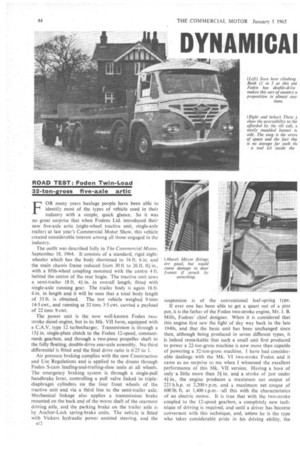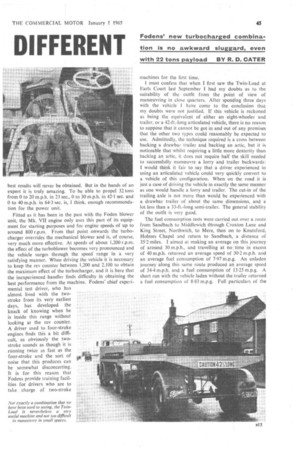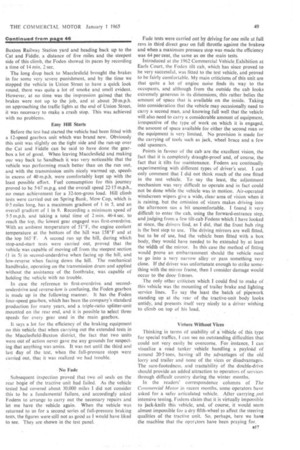DYNAMIGAI DIFFERENT
Page 46

Page 47

Page 48

Page 51

If you've noticed an error in this article please click here to report it so we can fix it.
ROAD TEST; Foden Twin-Load 32-ton-gross five-axle artic FOR many years haulage people have been able to identify most of the types of vehicle used in their industry with a simple, quick glance. So it was no great surprise that when Fodens Ltd. introduced their new five-axle artic (eight-wheel tractive unit, single-axle trailer) at last year's Commercial Motor Show, this vehicle created considerable interest among all those engaged in the industry.
The outfit was described fully in The Commercial Motor, September 18:1964. It consists of a standard, rigid eightwheeler which has the body shortened to 16 ft. 6 in. and the main chassis frame reduced from 30 ft to 26 ft. 01 in., with a fifth-wheel coupling mounted with the centre 4 ft. behind the centre of the rear bogie. The tractive unit tows a semi-trailer 18 ft. 41 in. in overall length, fitted with single-axle running gear. The trailer body is again 16 ft 6 in. in length and it will be seen that a total body length
of 33 ft. is obtained. The test vehicle weighed 9 tons 1+5 cwt., and running at 32 tons 3.5 cwt. carried a payload of 22 tons 9 cwt.
The power unit is the now well-known Foden twostroke diesel engine, but in its Mk. VII form, equipped with a C.A.V. type 12 turbocharger. Transmission is through a 15-1 in. single-plate clutch to the Foden 12-speed, constantmesh gearbox, and through a two-piece propeller shaft to the fully floating, double-drive rear-axle assembly. No third differential is fitted and the final drive ratio is 6-25 to L
Air pressure braking complies with the new Construction arid Use Regulations and is applied to the drums through Foden S-cam leading-and-trailing-shoe units at all wheels. The emergency braking system is through a single-pull handbrake lever, controlling a pull valve linked to triple: diaphragm cylinders on the four front wheels of the tractive unit and via a third line to the semi-trailer axle. Mechanical linkage also applies a transmission brake mounted on the back end of the worm shaft of the rearmost driving axle, and the parking brake on the trailer axle is by Anchor-Lock spring-brake units. The vehicle is fitted with Vickers hydraulic power assisted steering, and the n12 suspension is of the conventional leaf-spring type.
If ever one has been able to get a quart out of a pint pot, it is the father of the Foden two-stroke engine, Mr. J. B. Mills, Fodens' chief designer. When it is considered that this engine first saw the light of day way back in the late 1940s, and that the basic unit has been unchanged since then, although being produced in seven different types, it is indeed remarkable that such a small unit first produced to power a 22-ton-gross machine is now more than capable of powering a 32-ton-gross machine. I have had considerable dealings with the Mk. VI two-stroke Foden and it came as no surprise to me when I witnessed the excellent performance of this Mk. VII version. Having a bore of only a little more than 3+ in. and a stroke of just under 41 in., the engine produces a maximum net output of 225 b.h.p. at 2,200 r.p.ial and a maximum net .torque of 600 lb. ft. at 1,400 r.p.m.----all this with the characteristics of an electric motor. It is true that with the two-stroke coupled to the 12-speed gearbox, a completely new technique of driving is required, and until a driver has become conversant with this technique, and, unless he is the type who takes considerable pride in his driving ability, the
best results will never be obtained. But in the hands of an expert it is truly amazing. To be able to propel 32 tons from 0 to 20 m.p.h. in 23 sec., 0 to 30 m.p.h. in 42-1 sec. and 0 to 40 m.p.h. in 64-3 sec. is, I think, enough recommendation for the power unit.
Fitted as it has been in the past with the Foden blower unit, the Mk. VII engine only uses this part of its equipment for starting purposes and for engine speeds of up to around 800 r.p.m. From that point onwards the turbocharger overrides the mechanical blower and is, of course, very much more effective. At speeds of about 1,200 r.p.m. the effect of the turboblower becomes very pronounced and the vehicle surges through the speed range in a very satisfying manner. When driving the vehicle it is necessary to keep the rev counter between 1.200 and 2,100 to obtain the maximum effect of the turbocharger, and it is here that the inexperienced handler finds difficulty in obtaining the best performance from the machine. Fodens' chief experimental test driver, who has almost lived with the twostroke from its very earliest days, has developed the knack of knowing when he is inside this range without looking at the rev counter. A driver used to four-stroke engines finds this a bit difficult, as obviously the twostroke sounds as though it is running twice as fast as the four-stroke and the sort of noise that this produces can be somewhat disconcerting. It is for this reason that Fodens provide training facilities for drivers who are to take charge of two-stroke machines for the first time.
I must confess that when I first saw the Twin-Load at Earls Court last September I had my doubts as to the suitability of the outfit from the point of view of manceuvring in close quarters. After spending three days with the vehicle I have come to the conclusion that my doubts were not justified. If this vehicle is reckoned as being the equivalent of either an eight-wheeler and trailer, or a 42-ft.-long articulated vehicle, there is no reason to suppose that it cannot be got in and out of any premises that the other two types could reasonably be expected to use. Admittedly, the technique required is a cross between backing a drawbar trailer and backing an artic, but it is noticeable that whilst requiring a little more dexterity than backing an artic, it does not require half the skill needed to successfully manceuvre a lorry and trailer backwards: I would think it fair to say that a driver experienced in using an articulated vehicle could very quickly convert to a vehicle of this configuration. When on the road it is just a case of driving the vehicle in exactly the same manner as one would handle a lorry-and trailer. The cut-in of the trailing axle is not more than would be experienced with a drawbar trailer of about the same dimensions, and a lot less than a 33-ft.-long semi-trailer. The general stability of the outfit is very good.
The fuel consumption tests were carried out over a route from Sandbach to Middlewich through Croxton Lane and King Street, Northwich, to Mere, then on to Knutsford, Holmes Chapel and return to Sandbach,1 a distance of 35-2 miles. I aimed at making an average On. this journey of around 30 m.p.h., and travelling at no time in excess .3
of 40 m.p.h. returned an average speed of 1 0-2 m.p.h. and an average fuel consumption of 7-97 m.p.14 . An unladen journey along this same route produced an average speed of 34-4 m.p.h. and a fuel consumption of I3-25 m.p.g. A short run with the vehicle laden without the Itrailer returned a fuel consumption of 8-83 m.p.g. Full particulars of the
fuel consumption can be seen in the information panel.
To assess the capabilities of this machine in difficult country I made a journey from Sandbach along the A534 to Congleton and Macclesfield and up over the Cat and Fiddle to Buxton in Derbyshire. Climbing up from Macclesfield to the Cat and Fiddle, a distance of around six mites, 814
all of fairly punishing gradients, the Foden took 21 min. 26.6 sec. and the minimum speed recorded during this climb was 1-2.5 m.p.h. The braking system proved to be well up to the job when descending to Buxton, which was made in high-third, medium-top and high-top. Turning round in
Buxton Railway Station yard and heading back up to the Cat and Fiddle. a distance of five miles and the steepest side of this climb, the Foden showed its paces by recording a time of 14 min, 2 sec.
The long drop back to Macclesfield brought the brakes in for some very severe punishment, and by the time we stopped the vehicle in Union Street to have a quick look round, there was quite a lot of smoke and smell evident. However, at no time was the impression gained that the brakes were not up to the job, and at about 20 m.p.h. on approaching the traffic lights at the end of Union Street, it was necessary to make a crash stop. This was achieved
with no problems. • Easy Hill Starts Before the lest had started the vehicle had been fitted with a 12-speed gearbox unit which was brand new. Obviously this unit was slightly on the tight side and the run-up over the Cat and Fiddle can be said to have done the gearbox a lot of good. When leaving Macclesfield and making our way back to Sandbach it was very noticeable that the vehicle was performing much better than on the run out, and with the transmission units nicely warmed up, speeds in excess of 40 m.p.h. were comfortably kept up with the least possible effort. Fuel consumption• for this journey proved to be 567 m.p.g. and the overall speed 22.15 m.p.h., no mean achievement for a 32-ton-gross load. Hill climb tests were carried out on Spring Bank, Mow Cop, which is 0.5 miles long, has a maximum gradient of I in 5, and an overall gradient of 1 in 9. Recording a minimum speed of 5.5 m.p.h. and taking a total time of 2 min. 46-4 sec. to reach the top, the ldwest gear engaged was first-overdrive. With an ambient temperature of 51°F, the engine coolant temperature at the bottom of the hill was 158°F and at the top 165`F. A second run up the hill, during which stop-and-start tests were carried out, proved that the vehicle was capable of moving off from the steepest section (I in 5) in second-underdrive when facing up the hill, and low-reverse when facing down the hill. The mechanical handbrake, operating on the transmission drum and applied without the assistance of the footbrake, was capable of holding the vehicle with no trouble.
In case the reference to first-overdrive, and secondunderdrive and reverse-low is confusing, the Foden gearbox is made up in the following manner. It has the Foden four-speed gearbox, which has been the company's standard production for many years, and a triple-ratio splitter-unit mounted on the rear end, and it is possible to select three speeds for every gear used in the main gearbox.
It says a lot for the efficiency of the braking equipment on this vehicle that when carrying out the extended tests in the Macclesfield-Buxton district, the fact that two units were Out of action never gave me any grounds for suspecting that anything was amiss. It was not until the third and last day of the test, when the full-pressure stops were carried out, that it was realized we had trouble.
No Fade Subsequent inspection proved, that two oil seals on the rear bogie of the tractive unit had failed. As the vehicle tested had covered about 30,000 miles I did not consider this to be a fundamental failure, and accordingly asked Fodens to arrange to carry out the necessaryrepairs and let me have the vehicle again. When the vehicle was returned to us for a second series of full-pressure braking tests, the figures were stilt not as good as I would have liked to see. They are shown in the test panel. Fade tests were carried out by driving for one mile at full revs in third direct gear on full throttle against the brakesp and when a maximum pressure stop was made the efficiency was 64 per cent, the same as on the main tests.
Introduced at the 1962 Commercial Vehicle Exhibition at Earls Court, the Foden tilt cab, which has since proved to be very successful, was fitted to the test vehicle, and proved to be fairly comfortable. My main criticisms of this unit are that quite a lot of engine noise finds its way to the occupants, and although from the outside the cab looks extremely generous in its dithensions, this rather belies the amount of space that is available on the inside. Taking into consideration that the vehicle may occasionally need to carry a second man, and knowing full well that the vehicle will also need to carry a considerable amount of equipment, irrespective of the type of work on which it is engaged, the amount of space available for either the second man or the equipment is very limited. No provision is made for the carrying of tools such as jack, wheel brace and a few odd spanners.
Points in favour of the cab are the excellent vision, the fact that it is completely draught-proof and, of course, the fact that it tilts for maintenance. Fodens are continually experimenting with different types of driver's seat. I can only comment that I did not think much of the one fitted in the test vehicle. To say the least, the adjustment mechanism was very difficult to operate and in fact could not be done while the vehicle was in motion. Air-operated windscreen wipers give a wide, clear area of vision when it is raining, but the omission of vizors makes driving into the afternoon sun a bit uncomfortable. I found it very difficult to enter the cab, using the forward-entrance step, and judging from a few tilt-cab Fodens which I have looked at since, the drivers find, as I did, that the front hub ring is the best step to use. The driving mirrors are well fitted, but to be of use, had the vehicle been fitted with a box body, they would have needed to be extended by at least the width of the mirror. In this case the method of fitting would prove an embarrassment should the vehicle need to go into a very narrow alley or pass something very close. If thd. driver was unfortunate enough to strike something with the mirror frame, then I consider damage would occur to the door frames.
The only other criticism which I could find to make of this vehicle was the mounting of trailer brake and lighting service lines. To say the least the batch of pipework standing up at the rear of the tractive-unit body looks untidy, and presents itself very nicely to a driver wishing to climb on top of his load.
Virtues Without Vices
Thinking in terms of usability of a vehicle of this type for special traffics, I can see no outstanding difficulties that could not very easily be overcome. For, instance, I can visualize a road tanker vehicle handling a payload of around 20-5 tons, having all the advantages of the old lorry and trailer and none of the vices or disadvantages. The sure-footedness, and tractability of the double-drive should provide an added attraction to operators of services through difficult country during the winter months.
In the readers' correspondence columns of The Commercial Motor in recent months, some operators have asked for a safer articulated vehicle. After carrying ,out intensive testing, Fodens claim that it is virtually impossible to jack-knife this vehicle, and, of course, it would seem almost impossible for a dry fifth-wheel to affect the steering qualities of the tractive unit. So, perhaps, here we have the machine that the 01)2r:tors have been praying for.




























































































